Territories observed
- Egypt
- Sudan
- Ethiopia
- Kenya
- Tanzania
- South Africa
Similarities observed
- Heavy Chinese enterprise involvement in the building of roads and houses
- Shops with Chinese labels observed in operation
- In areas where there are construction operations, Chinese supervision and management observed aided by local manual labor
- Ubiquity of mobile internet connection
- Ubiquity of Samsung, Huawei and Tenco Android mobile phones ranging from USD50 among local adult and adolescent population
Macro trends
With the rise of the Chinese middle class, there is now increasing domestic demand for goods and services within China. This has driven the need to increase the overall throughput volume of such commodities. It can be speculated that the level of consumption is expected to surpass the level of production within China at some point.
Economic growth in China has for now hit a road block due to the following factors:
- Increased overall cost of production in China leading to less competitive exports
- Increasing headwinds from US-Chinese trade tensions with the shift from the US policy that has been in place since President Nixon
- Domestic construction demand saturation
In light of these, China needs to start shifting its policy from an export focused economy to a domestic focused economy. To do so, it needs to feed and drive domestic demand for goods and services.
Regional trends
The Chinese government has been observed to enter into agreement with local African government to fund the build out of infrastructure, primarily roads and buildings. At the date of writing 85% of roads in Ethiopia has been completed within the country while in Zanzibar, Tanzania, all major roads are under construction and a sports stadium named Mao ZeDong stadium has been observed.
In exchange for the funding, local governments are restricted to engaging the service of Chinese companies. This safeguards the effectiveness of funds deployment for the operations aspects of the agreement while serving to three specific purposes. It minimizes the actual volume of liquidity that is tied up in loans to local government, while boosting demand for construction services within China and increasing maximum possible throughput volume of commodity exports from the region.
What is not obvious during the time of observation is how effective local governments are at managing funds during the stage between its receipt from China to its payment to the engaged Chinese companies. Discounting the inherent effectiveness of the various projects in driving local GDP, differing levels of corruption and maturity of national identify within the region will result in variance between actual ROI versus expected ROI for these projects.
On deciphering Chinese end goal within the region
At the moment of writing, it is yet clear how Chinese African relationship will crystalize for the future. Two key observations need to be made before we can get a glimpse of it.
Key observation #1 would be how China would react when the loans come to maturity and the local government have yet made sufficient returns from the infrastructure investments to pay off the debt.
Key observation #2 would be how Chinese companies would handle the post construction phase of projects that require ongoing maintenance in terms of knowledge transfer.










